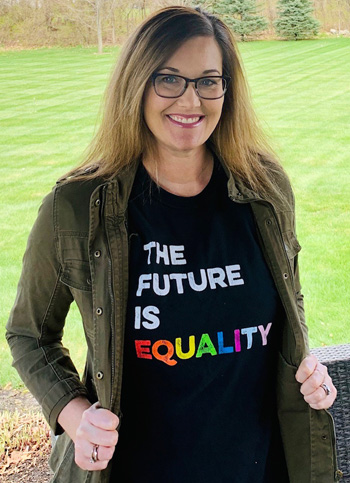April 28, 2020
 This is the eighth in a series of guest blogs by the 2019-20 Michigan Regional Teachers of the Year. Kristalyn Musselman is a health and leadership teacher at Tecumseh High School in Tecumseh Public Schools.
This is the eighth in a series of guest blogs by the 2019-20 Michigan Regional Teachers of the Year. Kristalyn Musselman is a health and leadership teacher at Tecumseh High School in Tecumseh Public Schools.
One of the most important things I’ve learned in my 14 years of teaching is that as educators, we teach more than just content. We have to be more than just a teacher. And we have to create an inclusive learning space so that ALL of our students can feel safe, supported and ready to learn. This includes one of our most marginalized populations, our students who identify as LGBTQ (Lesbian, Gay, Bisexual, Transgender or Queer/Questioning).
There are still many stigmas associated with LGBTQ individuals, and much of this is due to a lack of understanding that breeds prejudice and discrimination. If teachers want to be supportive and become an ally for our LGBTQ students, we must educate ourselves on the full range of identities that our kids will be bringing into our space.
If the goal of education is to ensure children can learn, grow, reach their potential and become contributing members of society, their basic needs must be met first. Decades of research has shown that foundational needs must be met for learning to occur. When our marginalized students feel unsafe physically and emotionally, they can’t and don’t learn. Schools are responsible for providing a safe learning environment for all students. However, for many kids, especially those who identify as LGBT, school is not a safe place.
There are many ways that our school districts can help. Districts with anti-bullying and anti-harassment policies can and should be enumerated to include “gender identity, gender expression and sexual orientation.” Policies like this can be a really powerful way to support our LGBTQ kids and make the statement that ALL of our kids matter. Schools with a GSA (Gay Straight Alliance) or Pride Club can help to connect our LGBTQ students to school and provide a safer environment. Kids who feel connected come to school more often, and in turn, that impacts grades and achievement.
In the classroom, teachers can be a tremendous ALLY. Creating a classroom environment where everyone feels safe and valued is an amazing first step to helping every student feel their presence is important, regardless of gender identity and sexual orientation.
Assume Your Class Is Diverse
Start with the assumption that your class has students with a variety of genders and sexual identities. By doing this, you’ll be more likely to communicate acceptance. Use diverse examples of same-sex relationships and diverse families! Even students who are not LGBTQ themselves may have diverse family structures that include one or more LGBTQ parents or guardians, or they may not be living with parents at all! Be careful what language you use when talking about home-life. Try using “parent, guardian, caregiver …” instead of “mother and father.”
Use Correct Pronouns
It’s critical to use correct pronouns if you have a transgender student that prefers a name other than the one assigned at birth. Consider how you (or a substitute teacher) will take attendance. Verbally calling someone by a name other than what they prefer can be emotionally damaging and affect their world in ways we may never realize. Consider alternative ways to take attendance so you (or a substitute) are not saying the incorrect name. No teacher wants to “out” their students in front of their classmates, nor in front of their parents/guardians at conferences. Communicate with your student ahead of time so you’re aware if the student has a parent or caregiver that is unsupportive of their transition.
Designate Your Classroom a ‘Safe-Zone’
Safe spaces make a big difference in LGBTQ students' perceptions that their schools are safe and that their teachers are adults they can trust. Hanging stickers or posters is not just a sign that you support the LGBT community, but it signals to LGBTQ youth that you've got their backs.
Speak Up Against Offensive Statements
If homophobic or transphobic language is used by a student, don't ignore it! Speak up against biased or offensive statements, EVERY TIME – no exceptions. Respond to biased or homophobic behavior as if there is an LGBTQ student in the room at all times. As educators, we may never fully understand the extent to which students are impacted by hearing hurtful statements.
In the end, it’s not about what you believe and what I believe or what political platform we stand on. As educators, we have a common goal despite our differences, and we should focus on that common goal: helping ALL students find success in Michigan schools.